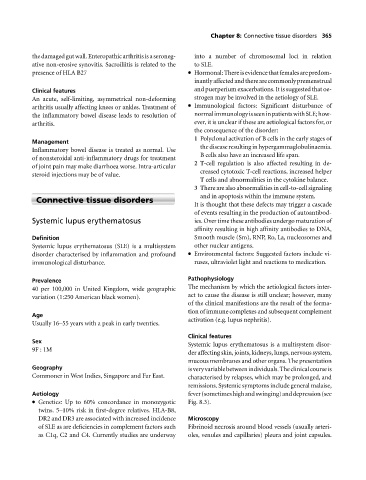Page 369 - Medicine and Surgery
P. 369
P1: KTX
BLUK007-08 BLUK007-Kendall May 12, 2005 19:48 Char Count= 0
Chapter 8: Connective tissue disorders 365
thedamagedgutwall.Enteropathicarthritisisaseroneg- into a number of chromosomal loci in relation
ative non-erosive synovitis. Sacroiliitis is related to the to SLE.
presence of HLA B27 Hormonal:Thereisevidencethatfemalesarepredom-
inantlyaffectedandtherearecommonlypremenstrual
Clinical features and puerperium exacerbations. It is suggested that oe-
An acute, self-limiting, asymmetrical non-deforming strogen may be involved in the aetiology of SLE.
arthritis usually affecting knees or ankles. Treatment of Immunological factors: Significant disturbance of
the inflammatory bowel disease leads to resolution of normalimmunologyisseeninpatientswithSLE;how-
arthritis. ever, it is unclear if these are aetiological factors for, or
the consequence of the disorder:
1 Polyclonal activation of B cells in the early stages of
Management
the disease resulting in hypergammaglobulinaemia.
Inflammatory bowel disease is treated as normal. Use
Bcells also have an increased life span.
of nonsteroidal anti-inflammatory drugs for treatment
2 T-cell regulation is also affected resulting in de-
of joint pain may make diarrhoea worse. Intra-articular
creased cytotoxic T-cell reactions, increased helper
steroid injections may be of value.
Tcells and abnormalities in the cytokine balance.
3 There are also abnormalities in cell-to-cell signaling
and in apoptosis within the immune system.
Connective tissue disorders
It is thought that these defects may trigger a cascade
of events resulting in the production of autoantibod-
Systemic lupus erythematosus ies. Over time these antibodies undergo maturation of
affinity resulting in high affinity antibodies to DNA,
Definition Smooth muscle (Sm), RNP, Ro, La, nucleosomes and
Systemic lupus erythematosus (SLE) is a multisystem other nuclear antigens.
disorder characterised by inflammation and profound Environmental factors: Suggested factors include vi-
immunological disturbance. ruses, ultraviolet light and reactions to medication.
Prevalence Pathophysiology
40 per 100,000 in United Kingdom, wide geographic The mechanism by which the aetiological factors inter-
variation (1:250 American black women). act to cause the disease is still unclear; however, many
of the clinical manifestions are the result of the forma-
tion of immune complexes and subsequent complement
Age
activation (e.g. lupus nephritis).
Usually 16–55 years with a peak in early twenties.
Clinical features
Sex
Systemic lupus erythematosus is a multisystem disor-
9F : 1M
der affecting skin, joints, kidneys, lungs, nervous system,
mucous membranes and other organs. The presentation
Geography isveryvariablebetweenindividuals.Theclinicalcourseis
Commoner in West Indies, Singapore and Far East. characterised by relapses, which may be prolonged, and
remissions. Systemic symptoms include general malaise,
Aetiology fever(sometimeshighandswinging)anddepression(see
Genetics: Up to 60% concordance in monozygotic Fig. 8.3).
twins. 5–10% risk in first-degree relatives. HLA-B8,
DR2 and DR3 are associated with increased incidence Microscopy
of SLE as are deficiencies in complement factors such Fibrinoid necrosis around blood vessels (usually arteri-
as C1q, C2 and C4. Currently studies are underway oles, venules and capillaries) pleura and joint capsules.

